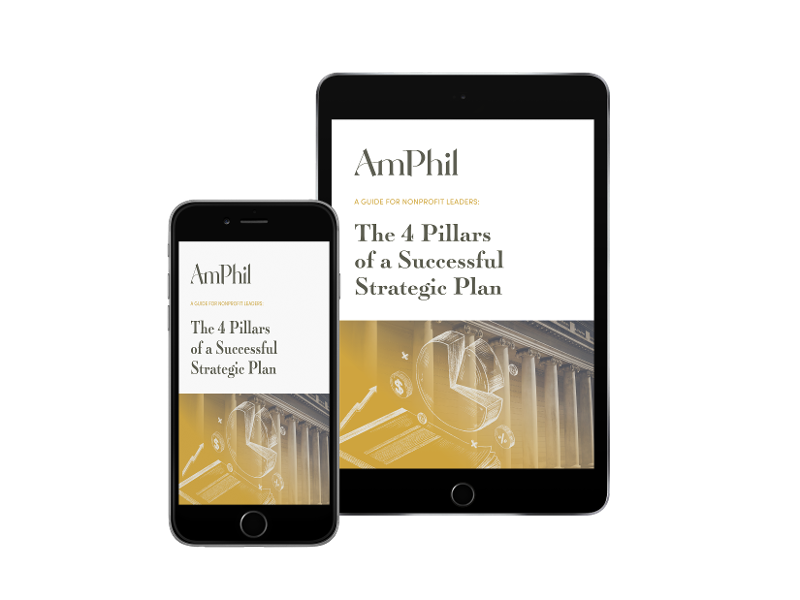
Successful fundraising requires a solid strategy. Too often, development directors and nonprofit leaders wear too many hats and juggle too many projects, and setting a strategy gets lost in the shuffle. The problem with this is that it makes fundraising reactive rather than proactive.
While any solvent organization is certainly having some fundraising success, taking time to set plans, goals, and strategies can take your fundraising to the next level. Smart planning makes development operations less frenzied, allowing you to devote more attention to other essential and programmatic decisions. The end of one year and the beginning of the next is a natural time to pause for a few hours, gather your team, and set high-level plans and goals for the year.
Here are five recommendations to set your development operations up for success and plan a year of proactive fundraising.
Revisit Your Case for Donor Support
It is essential that you know why you do what you do and that everyone at your organization is clear on the messaging and the case for support. There is great value in refocusing, reorienting your staff, and making sure that everyone is clear on your identity, your value proposition, your mission, and your vision.
This conversation—which will remind your staff why they do what they do, and why they care about the organization—will set the stage for the following planning steps. Revisiting the mission and vision shouldn’t only happen once a year either. One good practice is to pick one staff person at random during all-staff meetings and ask them to give the organization’s elevator pitch. (This is an excellent practice for board meetings, too—remember that they aren’t in the trenches with you day in, day out. Take five minutes during board meetings to touch base about the organization’s identity and how to share it concisely with outsiders.
Set Goals and Priorities for the Year Ahead
Gather your leadership and identify key priorities for the year ahead and ensure consensus. Do the development staff know the program staff’s goals and exactly why they are raising money? Does the program staff know that they need to be ready to support development operations and that their programs need to be realistic (according to the budget) and focused?
Use this opportunity to set revenue goals and programmatic goals and discuss how each department director will oversee their department. What key performance indicators will each manager use to ensure success on their team? How will they be keeping their staff accountable without micromanaging?
Lay Out a 12-Month Schedule for Communications
Setting a comprehensive, integrated communications calendar at the beginning of the year is invaluable. You want to take some time to determine when you are sending mail—cultivation, and solicitation—and to set the high-level themes for each mailing.
After you have drop dates and themes set, back out the timeline: talking points by X day, draft copy by Y day, final copy by Z day, and so on. This may seem innocuous, but it will save you lots of gray hair and stress to have these target dates in place ahead of time.
Once you have your direct-mail calendar drafted, you want to integrate other communications: when are you dropping newsletters or annual reports (and how will they affect your direct-mail calendar)? What email campaigns do you want to be integrated with your mail, and how extensive should they be? What digital communications will take place when mail isn’t going out? What will major donors receive and how do donor club members fit in the mail calendar?
Finally, once the communications calendar is established, share it with everyone at the organization. Break down silos by making sure the entire staff is aware of what other departments are doing. Communications calendars are not the exclusive possession of a communications department and should not be treated that way.
Create a 12-Month Calendar for Grants
You want to take stock of all foundation grantees and determine when you owe them reports when they have deadlines or board meetings, and when you should be applying for renewals. With a high-level grants calendar, you should be able to house all your foundation's activity in one place.
Furthermore, foundations outreach is so often reactive: you are reminded (by a program officer or a calendar reminder you set a year ago, maybe an automated email) that you owe the foundation a report on whatever date. Your staff then scramble to acquire the information, prepare the report, and submit it at the eleventh hour. Instead of reacting and scrambling like this, a grants calendar will provide a comprehensive look at all open foundation grants.
Of course, it is always wise to be optimistic about renewals. That means you want to have a report ready before the last minute so that you can then quickly turn around a new proposal. And, most importantly, remember that relationships are essential in foundations fundraising, too. Don’t just submit a report and then ask if they would welcome a new proposal. With a grants calendar, you can schedule additional meetings.
If you owe a report in September, plan an update meeting in March. It might be in person or over the phone, but take some time to let your contact at the foundation know how things are going. This is valuable for maintaining the relationship and teeing up the renewal, but it also gives you a chance to explain how things are going. This is extremely important if things are changing during your use of the grant. Are the results less promising than you expected? More promising? Different? Will it take longer to execute than anticipated? Or maybe you are wrapping up early—can you request a renewal grant sooner than anticipated to grow the project?
Some of these questions might throw up red flags to a grantmaker if they don’t know you well or come in over email—but if you can converse with them, you can address these things carefully and candidly. Grantmakers know that things don’t always go according to plan: changes can be okay—even a positive sign if they indicate your nimbleness, your intelligent response in the face of anomalies—but you need to be able to honestly explain the changes and why they aren’t a result of negligence or stupidity.
Prepare Individualized Donor Plans
The extensiveness of these plans will vary widely based on the organization: how many donors you have, how many major gifts officers, whether you manage your own caseload or just assist the MGOs, and so on. What is essential, though—and applies to every organization—is that you have individual plans for each of your donors.
Just as with foundation fundraising, you want to have a major gifts calendar. This will likely be a good deal more complex, but it is the same principle. Look at each of your major donors—when they gave, how much they gave, how long they’ve been giving, and whether and when they’ve upgraded—and then plan some basic strategy notes. If “Sally” makes a gift in September each year, plan to see her a few months earlier to say hello and thank you and to update her. If she’s been giving $10,000 a year for five years and is extremely happy with your organization, she’s likely ready for an upgrade—but your cultivation meeting in April or May will help you feel that out.
Looking at this from a “30,000-foot view” at the beginning of the year also aids efficiency. You don’t merely want to see a donor four months before he usually makes his gift—you also want to ensure you aren’t flying to Chicago every other week. When you have a full major donor calendar prepared, you can look at your donors by city and try to group them: plan to see them three to six months before when they usually make a gift. That three-month window gives you plenty of space to group donors into one trip. Once you have donor trips set, see what prospects and foundations are in the area to make your trip as efficient and effective as possible.
When these plans and strategies are in place, fundraising will be less hectic and reactive. Your development staff will waste less time and increase the likelihood of hitting—and exceeding—their goals. Moreover, this planning should not be a great burden in itself. Task various staff persons with preparing these calendars and review them during all-staff meetings.
Finally, and most importantly, despite how important these plans and goals are, take care not to become enslaved to them. It is crucial to be nimble throughout the year—planning should enable, not prevent, pivoting in response to the news cycle, organizational changes, and programmatic growth.
About the Author
Doug Schneider is AmPhil's Managing Partner and has nearly two decades of experience in sales,  marketing, communications, and fundraising. Before joining AmPhil, Doug served as the director of development for the Intercollegiate Studies Institute (ISI). In this capacity, he managed ISI’s annual fund, was part of ISI’s management team, and oversaw the institute’s marketing and communications efforts.
marketing, communications, and fundraising. Before joining AmPhil, Doug served as the director of development for the Intercollegiate Studies Institute (ISI). In this capacity, he managed ISI’s annual fund, was part of ISI’s management team, and oversaw the institute’s marketing and communications efforts.
As a partner at AmPhil, Doug works with a wide range of nonprofit organizations, with a focus on strategic planning and high-level development management. Doug regularly speaks on a variety of development-related topics, including major gifts, mission campaigns, and annual fund donor growth strategies leading fundraising training sessions for the State Policy Network, the Charles Koch Institute, and Foundation Center, among other venues.
Doug graduated magna cum laude with a degree in political science from Messiah College in Grantham, Pennsylvania. He has served on several local nonprofit boards and resides in Newark, Delaware, with his wife and their four children.
Connect with Doug on LinkedIn here or contact him anytime at doug@amphil.com.


